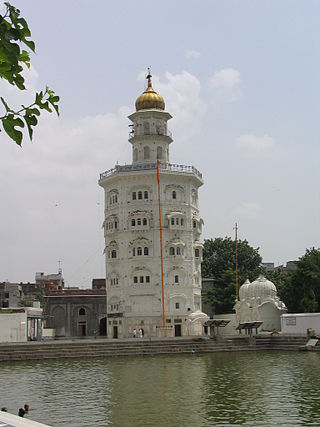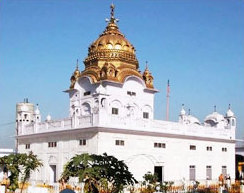
Nankana Sahib is a city and capital of Nankana Sahib District in the Punjab province of Pakistan. It is named after the first Guru of the Sikhs, Guru Nanak, who was born in the city and first began preaching here. Nankana Sahib is the most important religious site for the Sikh religion. It is located about 91 km (57 mi) west of Lahore and about 75 km (47 mi) east of Faisalabad. According to the census of 2017 the city has a population of 79,540 inhabitants. Until 2005, it was a part of the Sheikhupura District.
A gurdwara is a place of assembly and worship for Sikhs. Sikhs also refer to gurdwaras as Gurdwara Sahib. People from all faiths are welcomed in gurdwaras. Each gurdwara has a Darbar Sahib where the current and everlasting guru of the Sikhs, the scripture Guru Granth Sahib, is placed on a takhat in a prominent central position. Any congregant may recite, sing, and explain the verses from the Guru Granth Sahib, in the presence of the rest of the congregation.
The following outline is provides an overview of Sikhism, or Sikhi.

Udasi is a religious sect of ascetic sadhus centred in northern India. Becoming custodians of Sikh shrines in the 18th century, they were notable interpreters and spreaders of the Sikh philosophy during that time. However, their religious practices border on a syncretism of Sikhism and Hinduism, including idolatry, and they did not conform to the Khalsa standards as ordained by Guru Gobind Singh. When the Lahore Singh Sabha reformers, dominated by Tat Khalsa Sikhs, would hold them responsible for indulging in ritual practices antithetical to Sikhism, as well as personal vices and corruption, the Udasi mahants were expelled from the Sikh shrines.

Baba Gurditta was the son of Guru Hargobind, and the father of Guru Har Rai of Sikhism. There is a gurudwara in Kiratpur Sahib, Punjab which is in remembrance of Baba Gurditta.

Gurdwārā Bābā AṭṭalRai is a famous Gurdwara in Amritsar. dedicated to Atal Rai, a son of Guru Hargobind and Mata Nanaki. It is just a short walk from the famous Harmandir Sahib.

Dera Baba Nanak is a town and a municipal council in Gurdaspur district, in the state of Punjab, India. It is 36km away from Gurdaspur city, the capital of the district. Since November 2019, a corridor between India and Pakistan has been established at its shrine.

Nanakpanthis is a Sikh sect which refers to followers of the teachings of Guru Nanak (1469-1539), the foundational guru of a spiritual community natively known as Nanakpanth while known world-wide as Sikhism. Nanakpanth is an open frontier that references strongly an early Sikh community. Nanakpanthi signifies any person, regardless of any religious affiliation, who follows Guru Nanak and believes in his teachings of Universal brotherhood, Truth, Love, Tolerance, Compassion and most importantly Oneness of one single formless Waheguru.

Hari Parbat, also called Koh-i-Maran, is a hill overlooking Srinagar, the largest city and the capital of Jammu and Kashmir, India. It is the site of a fort, built by the Durrani Empire, and of a Hindu temple, mosques, and gurdwara.

Sikhism in Scotland includes all aspects of Sikh life and Sikhism in Scotland. Sikhs have been present in Scotland for over a century, with the first documented Sikh, Maharaja Daleep Singh, arriving in Perthshire in 1855. The next wave of migration was in early-to-mid 1920s when prominent Sikhs of the Bhat/Bhatra community established themselves in Glasgow and Edinburgh. However, the bulk of Sikhs in Scotland come from families who immigrated during the late 20th century. In Scotland Sikhs represent 0.2% of the population (9,055).

Gurū Nānak, also referred to as Bābā Nānak, was the founder of Sikhism and is the first of the ten Sikh Gurus. His birth is celebrated worldwide as Guru Nanak Gurpurab on Katak Pooranmashi, i.e. October–November.

Hazur Sahib, also known as Takht Sachkhand Sri Hazur Abchalnagar Sahib, is one of the five takhts in Sikhism. The gurdwara was built between 1832 and 1837 by Maharaja Ranjit Singh (1780–1839). It is located on the banks of the Godavari River at the city of Nanded in the state of Maharashtra, India.

Nanakmatta is a historical town named after the Sikh pilgrimage site, Gurdwara Nanak Mata Sahib, in the state of Uttarakhand in India. Sikh tradition records that the site was once called Gorakhmata, a centre of Siddh-jogis named after the founder of their order, Gorakhnath, at the distance of 30 miles from Reetha sahib. In the Siddh-Gost in Guru Granth Sahib, the story of Guru Nanak on his first udasi is told, wherein he had a long discourse with siddhas on matters of religion and metaphysics. Tradition says that the place was renamed Nanakmatta to perpetuate the memory of Guru's visit. The town is associated with Guru Nanak Dev and Guru Hargobind. It is situated on the bank of Deoha stream, which has since been dammed into a reservoir named Nanak Sagar. The Gurudwara is located 15 kilometres west of Khatima Railway Station on road to Tanakpur. The holy shrine is near the town of Sitarganj. It is one of three Sikh Holy places in the state, with others being Gurdwara Hemkunt Sahib and Gurudwara Reetha Sahib.

Sikhism prohibits idolatry, in accordance with mainstream Khalsa norms and the teachings of the Sikh Gurus, a position that has been accepted as orthodox.

Guru Nanak Jhira Sahib is a Sikh historical shrine situated in Bidar, Karnataka. Gurdwara Nanak Jhira Sahib was built in 1948 and is dedicated to the first Sikh guru, Guru Nanak. Bidar has a very long association with Sikhism as this is the home town of Bhai Sahib Singh, one of the Panj Pyare, who offered to sacrifice their heads and were later baptised as the first members of the Khalsa.
Sub-traditions, also known as Samparda in the Punjabi language, are sub-traditions within Sikhism that believe in different approaches to practicing the religion. While all sampradas believe in Waheguru (God) and one creator, typically* reject idol worship or the caste system, different interpretations have emerged over time, some of which have a living teacher as the leader. The major historic traditions in Sikhism, states Harjot Oberoi, have included Udasi, Nirmala, Nanakpanthi, Khalsa, Sahajdhari, Namdhari Kuka, Nirankari and Sarvaria.

Gurdwara Chowa Sahib is a renovated gurudwara located at the northern edge of the Rohtas Fort, near Jhelum, Pakistan. Situated near the fort's Talaqi gate, the gurdwara commemorates the site where Guru Nanak is popularly believed to have created a water-spring during one of his journeys known as udasi.But parkash of guru granth sahib is not there.

The Kartarpur Corridor is a visa-free border crossing and religious corridor, connecting the Gurdwara Darbar Sahib, near Lahore in Pakistan to Gurudwara Dera Baba Nanak, Gurdaspur district, Punjab, India. The crossing allows devotees from India to visit the gurdwara in Kartarpur, Pakistan, 4.7 kilometres from the India–Pakistan border on the Pakistani side without a visa. However, Pakistani Sikhs are unable to use the border crossing, and cannot access Dera Baba Nanak on the Indian side without first obtaining an Indian visa or unless they work there.














